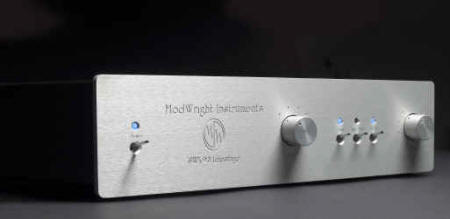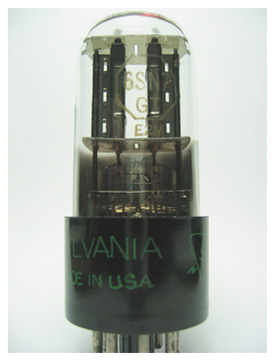You are reading the older HTML site
Positive Feedback
ISSUE
22
modwright
SWL 9.0SE linestage
as reviewed by Mark Katz

|
MARK KATZ'S SYSTEM
LOUDSPEAKERS
ELECTRONICS
SOURCES
CABLES
ACCESSORIES |
I was first intrigued by the concept of the ModWright preamp when I found out that Dan Wright was designing a line stage around the circuitry used in his excellent Sony 999 ES redesign. He took an already good CD/DVD/SACD player and turned it into a reference grade music reproducer. Dan kindly came down to Buena Park in June, 2005 to demonstrate his new preamp for the LA OC Audio Society. The unit I received, the SWL 9.0SE version, has superior parts from the base version and costs about $2,200. The faceplate is engraved, appears to be of brushed aluminum of substantial thickness, with solid feeling toggle and input selector switches, smoothly operating motorized potentiometer, and an easily visible blue on/off light. The RCA jacks on the rear are of high quality, well labeled and far enough apart to not be bothered by audiophile interconnects. The 9.0SE has five inputs, two outputs, tape loop, home theater bypass, mute, on/off switch, and a handy little remote control for volume and muting. The massive transformer used in the power supply adds weight to the unit. I think it's probably sufficient for a small amplifier, let alone a preamp. Maybe this accounts for some of the excellent dynamics. Its hybrid circuit is based around two 5687 tubes, very robust triodes used by Audionote and a few others.
I'm a fan of tube based preamps. The sense of space, truth of timbre, and just sounding musically right is something that, for me, is more likely to be achieved in a tube design than a solid state one. When someone designs a solid state unit that I find musically satisfying, I'm impressed. The stereotypical solid state virtues of quietness, clarity and frequency extension in bass and treble, on the other hand, are often missing in tube based preamps. I'll say upfront that the ModWright SWL 9.0SE provides the virtues of both technologies.
I listened with this unit as preamp in both my system and in Hajime Sato's, a fellow LA OC Audio Society member and excellent host who was interested in comparing tube preamps to the line stage of his Krell integrated. The Krell tends to sound better when it is left on longer, while the ModWright warms up nicely within a half hour or so. In Hajime's system, it was substituted for his Krell KAV 300iL's line stage in 2 channel mode which was driving a current production McIntosh 275 amp into Monitor Audio Silver S8 floor standing speakers on DH cones. The source was an Ah Super Tjoeb! 4000 CD player with all available upgrades. Power conditioning provided by a Monster 1100. Soundstring Alphas and Tributaries SCA 300 cables connected the components. First thing I noticed was the quietness of the unit, very comparable to the solid state Krell's low noise floor. When listening to vocals & jazz combos (Hajime's favorite music), the ModWright had a much better sense of space and better midrange texture. The jazz piece was Yoshiko Kishino's (piano trio) "Beautiful Love" from her album "Fairy Tale" (GRP Records, only available in Japan). Vocals were Holly Cole Trio's "I Can See Clearly Now" from album "Don't Smoke in Bed" (Manhattan). The Krell was flatter in soundstage and slightly grainier by comparison. Treble was surprisingly good on the solid state unit, the ModWright edging out the Krell in naturalness, but the Krell seemed more extended. Overall timbral accuracy of the ModWright was superior to the Krell. On piano, both had a nice sense of heft, with the ModWright line stage being a bit more articulate and better capturing the harmonic overtones. If thoroughly warmed up, the Krell KAV 300iL's line stage makes a very competent preamp. The ModWright SWL 9.0 SE was a step up.
My system consists of JM Lab Mezzo Utopias, with Kora Cosmos amps (with Dynamicaps), Muse 8 transport connected by a Marigo Ref 3 to the Kora Hermes II DAC (again with Dynamicaps), McIntosh MR-78 tuner, updated by Classic Audio. Goertz MI-2 copper speaker cables, Wireworld Eclipse III+ interconnects, and a PowerWedge 116II for power conditioning. I use the transformer filtered outlets only for low powered and digital electronics, i.e. Kora DAC, McIntosh tuner, Muse 8 transport. Preamps compared include the Kora Triode & Eclipse, Cary/AES-3 DJH edition line stage, and a much more expensive CAT Sig II phono/linestage. The ModWright was very quiet in my system. I heard no hum and barely audible hiss with head next to the tweeter. I don't actually listen to music this way! The ModWright was much more dynamic than the Kora Triode and slightly clearer, more forward and dynamic than its big brother Kora Eclipse, though the Koras had a sweeter (perhaps sweetened?) treble. My Eclipse is prior to the current circuit revision in about 2002.

The AES-3 DJH edition line stage is a chameleon. It is a small unit with three exposed vacuum tubes, three inputs, one output, and tube rectification. Change the 6SN7s and change the character. RCA 6SN7GTBs sound utterly relaxed and effortless, Pope (Phillips Holland special edition) powerful and more forward, Sylvania Chrome Domes (6SN7 GTBs with a large chrome colored getter on top) a bit more energetic, than but not quite as smooth as the tube I finally chose for the audition. For the purposes of comparison, I settled on some late 1940s Sylvania 6SN7 GTs. These particular vintage tubes are generally noisy and it takes a lot of looking to find a suitably quiet pair with low microphonics. This is a very enjoyable preamp for those who like pure tube sound and to fine-tune the character of a system through judicious tube choices. The ModWright SWL 9.0SE was more neutral with again excellent midrange texture, sense of space, and had greater heft on solo piano and orchestra. I preferred the Cary on things like solo guitar and female vocals, where the smoothness and delicacy came through, but even there the ModWright was musical and never etched, harsh or thin. To be fair, the ModWright costs half again as much as the Cary and one would hope for the more refined presentation for the money spent.
So how would it do against a much more expensive preamp? I invited Art Shapiro, another LAOC Audio Society Member, and Positive Feedback reviewer, to lend his ears and his CAT (Convergent Audio Technology) preamp to the auditioning effort. The CAT has long been acknowledged as an excellent unit both phono and line stage. Its power supply, attached by umbilical, alone is almost as big as the ModWright. The unit is more easily set up by two people since the power supply and main unit can't be detached from each other. Art's example dates from the early 1990s and was updated in 1995 to approximately Signature II status. As Art favors classical piano music, sometimes clattery or harsh, the slightly honey glazed, but powerful and detailed presentation is a very good match in his system. Current CAT Ultimates are purportedly more neutral and modern sounding, but the older CAT Signature still serves as a reference. [Yes, an audio pun.]
The listening session started with solo piano using one of my most familiar piano CDs, Earl Wild Plays his transcriptions of Gershwin, Chesky CD-032. Art's reaction was "it doesn't sound like solid state". At the time he had no idea what the technology of the preamp was and immediately noted the neutral, well balanced presentation, with excellent dynamics. I pointed out that it was a tube based unit. I played a variety of CDs over the afternoon, including orchestral, classical guitar, female and male solo and accompanied vocals, jazz combos, pipe organ, and even a track of a drum solo. In every case, the consensus was that it sounded very good and nothing was lacking. Then we put in the CAT. Bass seemed a bit tighter, the dynamics a bit better, but the unit made the system distinctly warmer sounding, adding this hint of coloration to all the pieces. Where the CAT shone was the detailing of the treble. While a flute with the ModWright in place sounded realistic, with the CAT one could hear the breathiness and vibrato more distinctly. The soprano's subtlety of expression and emotion came through more vividly. Piano overtones, especially in the upper registers were more prominent. Music seemed to have a greater sense of life. Whether this somewhat Technicolor presentation is accurate is debatable. It was involving and enjoyable. I put the ModWright back into the system and found most of the music still there and the system overall less colored.
The ModWright SWL 9.0SE preamp is well featured and modern sounding. It provides timbral rightness, sense of space, very good frequency extension, dynamic "heft", quietness, and the convenience of a remote control, all at a reasonable price in today's expensive high end market. It can easily provide the core of a 2 channel system or mixed home theater/2 channel and won't be embarrassed by units costing considerably more. Mark Katz
SWL 9.0SE linestage
Retail: $2200
ModWright
TEL: 503. 288. 5159
web address: www.ModWright.com
